An Introduction to Rollo Tomassi
Rollo Tomassi has been dubbed the “Godfather of the Red Pill” and his rise to fame has been in no small part from presenting “intrasexual dynamics” through the lens of evolutionary psychology. Men who struggled with women, be it from past experiences with infidelity, break-ups, or initial attraction, poured into “red pill” forums to find answers and seek help. In one presentation, Rollo Tomassi said the most frequent question he receives from men is “how do I get my girlfriend back.” Psychologists, too, were interested in answers to these same questions (maybe not “how do I get my girlfriend back” so much), albeit for different reasons.
There was a natural and understandable pull toward evolutionary psychology in the forums of the early 2010s; men discovered a whole field of scientists trying to discover the answers to questions that had direct implications for their own poor love lives. It was in this environment that Rollo Tomassi cut his teeth on the topic. He began a blog of his own musings, partly influenced by evolutionary psychology, and by 2013 published his first book based on his blog posts, The Rational Male.
Rollo Tomassi would deviate from psychologists in the field, however, by presenting a tabloid-esque parody of evolutionary psychology more akin to Jerry Springer than David Buss. His content would come to be dominated by social media beefs, celebrity gossip, and roundtable discussions with porn actresses and sex workers. His formal education in psychology would stop with his Bachelor’s degree and he would pick up the microphone, which is totally understandable, given how much more lucrative it is.
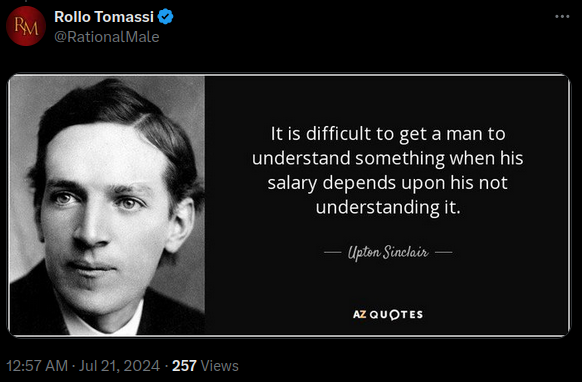
For many men, Rollo Tomassi was their first exposure to evolutionary psychology. He was an early adopter; he got in at the right time and was one of very few speaking about it outside of academic papers hidden behind paywalls. Good popular psychology books for a lay audience already existed, of course; David Buss wrote The Evolution Of Desire: Sexual Strategies of Human Mating in 1995. Rollo Tomassi would take these and repackage them as his own. Sexual Strategies Theory, for example, would become “Alpha Fucks/Beta Bucks,” or “AF/BB.”
Strategic pluralism, or the dual mating hypothesis proposed by Steven Gangestad and Jeffry Simpson, would also become “AF/BB.” Hypergamy, the observation that women select “up” in status, would too become “AF/BB.” Life history theory would also become “AF/BB.” The ovulatory shift hypothesis would also be “AF/BB.”
There was little that didn’t reduce to “AF/BB” in the mind of Rollo Tomassi. The important details of hypotheses, conflicts, and controversies in evolutionary psychology were ignored in this new-formed ideology.
For example, if a woman chose an attractive mate she was hypergamous, even if the man’s status was lower than her own. If she chose an unattractive mate then, once again, she was hypergamous if his income was higher. If a man chose a woman of lower status, however, he was not hypogamous. If men prioritized physical attractiveness in women — and the very Sexual Strategies Theory that Rollo Tomassi cribbed from proposes that men care about physical attractiveness even more than women — they were again for some reason not hypergamous. Hypergamy was simply the sexual strategy of women; it did not matter who they picked, because hypergamy was re-defined in such a way that women could never not be hypergamous. Hypergamy became a shifting goal post that could describe female behavior regardless of what they did.

This would become a pattern for Rollo Tomassi. The world would be a sort of Rorschach test for him where any and all events could be explained by “facts” and “hard truths” loosely based on what evolutionary psychologists understand to be (often controversial) hypotheses. He would use the terminology of evolutionary psychology in ways that evolutionary psychologists don’t, while still pointing at evolutionary psychology to validate his new dogma. It was our problem if we did not understand his unique redefinitions of the terms.
Meanwhile, it would become apparent that Rollo Tomassi rarely discussed evolutionary psychology in any depth.
What was astonishing to me when I was researching this article was that there was no indication he had ever read and summarized a paper from evolutionary psychology on his own. I searched his X/Twitter account for the domain names of common publishers like sciencedirect.com or apa.com and found that he only ever posted links or quotations from the abstracts. Much more often, academic information was a retweet/repost from other accounts. He had never once made a post with the phrases “effect size” or “effect sizes” in it that I found. He had never gone into the results or methods section of a paper and described them for his audience that I saw. I could not find even one instance where he reproduced a chart or table that was not taken from another social media account.
When he did post links to papers it was generally accompanied by a short one-liner like “the mate switching hypothesis has been debunked.” As often as not, the actual paper would say something completely different. It wouldn’t have even tested the claim that he had made about it. In some cases it had found the exact opposite of how he had presented it. It became clear that he probably wasn’t reading these and that, beyond learning a few concepts and some jargon, he didn’t understand evolutionary psychology all that well.
The Red Pill Has Little To Do With Evolutionary Psychology
In Rollo Tomassi’s first and most famous book, The Rational Male, he claims to draw heavily from evolutionary theory. I have little doubt evolutionary psychology influenced him, but in reality his own content is little more than his personal musings. His book contains virtually no references or citations; there is nothing to follow up on or fact check. He has produced no original empirical research. Some claims are loosely based on findings from evolutionary psychology, for example a female preference for dominant males in some contexts. Others are entirely spurious, for example, “evolution selected for human females with the capacity for solipsism.”
In over a decade of writing about “evolutionary psychology,” Rollo Tomassi has received no recognition of his work from evolutionary psychologists. He has made no friends nor peers among them. Evolutionary psychologists do not share nor promote his content; they have often declined his invitations to talk with him. Candidly, as someone whose work is occasionally shared by evolutionary psychologists and as someone who does talk to some of them, they seem to hate how he misrepresents their entire field.
Presenting “evolutionary psychology” for over a decade, one might think that receiving only negative responses from those in the field, or being ignored entirely, would be a strong form of natural feedback. You’d probably begin to ask yourself why everyone is avoiding you. Rollo Tomassi has noticed this, too, but instead of self-correcting he has invented conspiracy theories for why that is so. Evolutionary psychologists are “feminists” and “gatekeepers” who are afraid of the “hard questions” that he asks.
Nevermind that Rollo Tomassi has never asked a novel “hard question.” As I have written in the past, the red pill is intellectually sterile. It has come up with no new hypotheses nor ideas. The terms and hypotheses presented by Rollo Tomassi were all the ideas or concepts of smarter men and women: “the dual mating hypothesis,” “hypergamy,” or “sperm competition,” to select a few examples.
The “unflattering truths” that Rollo claims evolutionary psychologists are afraid to discuss with him are regularly discussed elsewhere. They are presented at academic conferences, on the social media of actual psychologists, on other podcasts (but not his), and regularly published in journals. They aren’t his ideas, after all. How could evolutionary psychologists be afraid to discuss what they, not him, came up with? The only difference is that evolutionary psychologists present these as hypotheses, not facts, and don’t use them to spin wild narratives beyond what they really are.
Given that Rollo Tomassi has not received the natural feedback from the field that he is getting it right — and in science this kind of feedback is a currency worth more than gold — you might expect him to self-correct. He doesn’t. Instead, as evolutionary psychologists have become more engaged with social media (and thus more inclined to correct misrepresentations of their work), Rollo Tomassi has responded by simply doubling down and shifting further away from evolutionary psychology. According to Rollo Tomassi, evolutionary psychology “hates the red pill” and has “sold out.”
You can read between the lines here — this simply means that evolutionary psychologists are producing a lot of research that does not support Rollo Tomassi’s dogma. He knows this.
For example, why did David Buss (and evolutionary psychology as a field more broadly) move away from the dual mating hypothesis toward the mate switching hypothesis? According to David Buss and other evolutionary psychologists, the dual mating hypothesis simply wasn’t enough to fully explain infidelity nor short-term sexual desire. Much of the supporting evidence from research on ovulatory shift effects had failed to replicate. This was enough for the originator of the dual mating hypothesis, Steven Gangestad, to say that he was not even sure he believed that the dual mating hypothesis was true any more.
For Rollo Tomassi, who has conducted no research of his own nor even completed graduate studies in the field of psychology, this was not enough. The real reason was a conspiracy: the feminists got to David Buss! There were too many women in psychology and they were fudging the results.
I would strongly recommend listening to Rollo Tomassi’s commentary on the interview between Joe Rogan and David Buss linked above, because it’s a great example of how Rollo Tomassi has no problem trying to tell experts how they got their own research wrong. This is a pattern.
In The Rational Male, Rollo Tomassi describes how his own professors in his undergraduate education also told him he was getting it wrong: “I should say that I did make an effort to propose that inter-gender relationships were based in, sometimes harsh, behaviorism with colleagues and teachers. I was kind of taken aback more often than not when the same teachers who were promoting behavioral psychology as a hard science were the most outspoken critics of what I was bringing to light for them. I couldn’t understand, then, what would possibly prevent them from connecting the dots and coming to the uncomfortable conclusions I was making.”
The obvious conclusion for a “rational” thinker might be that they knew something he didn’t: he was simply getting it wrong.
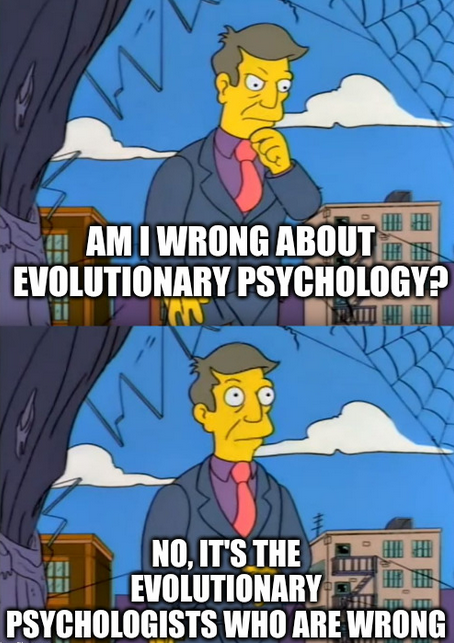
Feelings Over Facts: A Conspiratorial Thinking Style
As belief in conspiracy theories tends to cluster (individuals who believe in one tend to believe in others), it is unsurprising that Rollo Tomassi believes in many. That the recent assassination attempt of Donald Trump was a conspiracy is an obvious one for him to believe. A more wild one, going back to evolutionary psychology, is that a group of evolutionary psychologists researching incels were in fact federal agents. Or maybe we were “affiliate marketers?” It was never entirely clear, Rollo Tomassi found it very suspicious that we would share a study on social media, despite it being a very common method to recruit participants. Then later the “smoking gun” was an NGO that wanted to run targeted ads on manosphere platforms. This was entirely unrelated to incel research or any of the researchers involved, but somehow in the mind of Rollo Tomassi this was all connected. The psychologists are paid shills of the Diverting Hate NGO!
This one was a bit of a dud, which is unfortunate, because it was the first time I found myself embroiled in a conspiracy theory and I thought it was hilarious. It turned out that the full evidence against me was that I had shared the researchers’ study and made replies to the X/Twitter account of the main incel forum owner.
People who fall for or fabricate conspiracy theories are rarely careful thinkers, so they are often quick to jump the gun and spread misinformation. Because Rollo Tomassi cannot extricate himself from online drama and gossip, he also fell for a hoax perpetrated by YouTube influencer Brittany Venti to get him to believe Lauren Southern was pregnant with the child of influencer Destiny.
It’s important to understand individual differences in how people think, because you will begin to see how a thinking style manifests for a given individual across domains. This is a sloppy and incautious thinking style. It relies on emotional, superficial, and fast judgments of information. This is one reason why people who think this way are quick to fall for and quick to share misinformation. This thinking style is also characterized by forming illusory associations between events. They invent “alternative facts” about the world. For example, Rollo Tomassi’s unwavering belief that a standard copyright waiver used in academic publishing is evidence that the U.S. government was behind the research is further evidence, to him, that the researchers are connected to an entirely unrelated anti-manosphere NGO. We will see later in this article dozens of examples of how Rollo Tomassi makes spurious associations between entirely unrelated research findings, or misrepresents research findings entirely, all rooted in these underlying psychological tendencies.
Rollo Tomassi Has Little Familiarity With The Research Process
Beyond the copyright waiver conspiracy, a lot about the academic publishing process seems to confuse Rollo. In a recent exchange on X/Twitter I posted a new paper that, once again, failed to replicate ovulatory shift effects in mate preferences. He did not understand how the paper was published before the journal issue was published. It is standard that individual papers are published in full before the periodic issues of journals are published, but he could not shake the belief that something fishy was happening, and persisted in calling it an “unfinalized” paper. This despite the fact that the article was fully published, available as an open document on the journal website, and that the journal issue explained in big text at the very top of the page, “The issue is in progress but contains articles that are final and fully citable.”
I cannot imagine how he will react when he learns about preprints!
How Rollo Tomassi Turns Weak Results Into Grand Narratives
This is an example of motivated reasoning. Rollo Tomassi does this a lot. He didn’t like the result because, for some reason, he is ideologically wedded to ovulatory shift effects being real. Remember: to Rollo Tomassi, the ovulatory shift hypothesis is “AF/BB.” On the other hand, I don’t really care if they are real or not beyond my own curiosity. It changes little for me either way, but for someone who styles himself as a guru and who presents controversial hypotheses as “facts” it can be devastating to be wrong. For scientists, failed replications are simply a part of the process. Gurus, on the other hand, need grand narratives. They need big results that explain the world around them in meaningful ways. Psychology is not a great tool for this. The median effect size in psychology is small and it is well understood that no single thing explains all that much about complex human behavior.
Some ovulatory effects probably are real, I would be surprised if they were not, but they are also small in size and highly conditional. They don’t inherently imply a “dual mating strategy” nor anything about “AF/BB.” (Remember how I said Rollo Tomassi links unrelated things in his own mind?) There are multiple models that cyclic shifts are consistent with, such as the motivational priority shift hypothesis. Evolutionary psychologists don’t really know at the moment — and none are making the kinds of claims about cyclic shifts that Rollo Tomassi misrepresents from their work.
For example, commenting on the aforementioned Rogan and Buss interview, Rollo Tomassi claimed that female behavior and mating decisions “lined up perfectly” with ovulatory shifts. It’s a huge claim and, across all of the ovulatory shift research, you get an effect size of around .21. Far from lining up perfectly, the difference in mate preference shifts for a woman who is ovulating versus a woman who is not looks about like this:
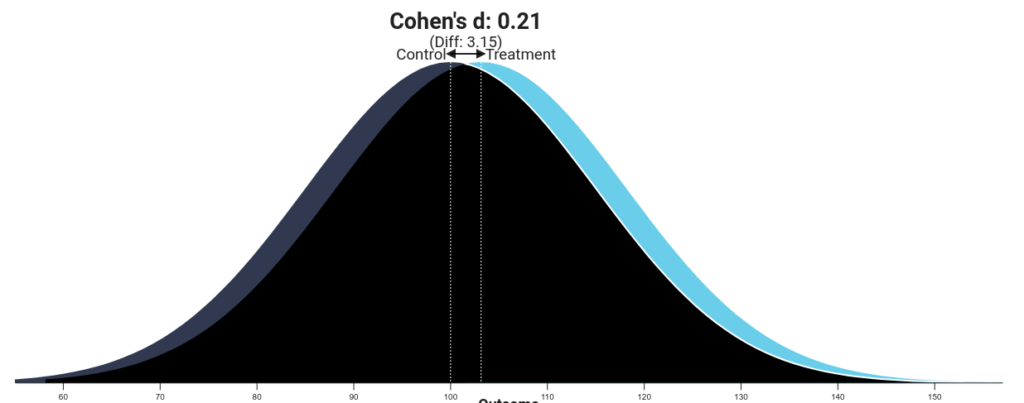
You could make very few predictions about individual women or individual behavior from this. There is only a 55.9% chance a woman picked at random from the non-ovulatory group would show a shift in mating preferences compared with the ovulatory group. It’s hardly better than chance. Cohen’s d conventions roughly specify that what you can observe with the naked eye is a d of around .3. This is fine for understanding general, vague trends across groups. It’s terrible for trying to predict individual behavior.
The general opinion of evolutionary psychologists who tend to fall on the “for” side is that some shifts are real, but that what effects are real are also small in size. This likely explains many failed replications: weak effects are hard to detect and thus hard to replicate. Not once, as far as I know, has Rollo Tomassi ever explained to his followers that these are small and inconsistent effects. In fact, he presents them as if they were large, stable, and have much explanatory value for female behavior.
This is a common problem in science communication and pop psychology in general: journalists or influencers tend to present “study finds,” but rarely discuss the size of effects. Human psychology is complex and multivariate, so individual effects often explain very little, even when they are real.
In a recent exchange with Rollo Tomassi, I asked him if he would share the effect sizes from a 2014 meta-analysis of ovulatory shift effects with his followers. This is a paper authored by Gildersleeve, Haselton, and Fales that Rollo Tomassi himself has posted a link to multiple times. His reply was that he couldn’t share it because I didn’t give him the link! In the same exchange, he wrote in respect to another paper by Haselton: “No link to the quoted screen cap. Almost like you’re hiding something.” The full citation was provided in the post (very easy to look up) and given how often he has posted a link to this very paper you might think he would be familiar with the reference, the results, and the chart.
He probably didn’t ever read the papers at all, but if he did then one might wonder why he has never been inclined to share the effect sizes from them, why he finds himself arguing against them when they are cited, and why he doesn’t seem to recognize them.
Rollo Tomassi loves name-dropping Martie Haselton a lot; he even has a link to her personal website on his blog. Yet in Haselton’s most recent review (2023) of the ovulatory shift research in Chapter 30 of the Oxford Handbook of Human Mating, she wrote, “Preference shifts appear to be very weak overall, limited to specific male traits, and/or conditional … in light of contrasting results, a number of research teams have sought to assess the replicability of key-findings in reasonably high-powered studies. Results have been mixed, though findings have been more negative than positive … claims based on early studies were likely too bold. If preference shifts exist, they are likely to be restricted to certain features.”
It’s hard to make strong claims from such weak effects. That’s fine for evolutionary psychologists, but less so if you intend to build a strong ideology of “AF/BB” around the results. Rollo Tomassi will not share the details of research like this because it undermines his ideology more than it supports it.
Ovulatory shift research isn’t an especially spicy topic (which is also why “feminists want to censor it” is a silly claim, although I am sure some do); I have written enough about it that I hate to dwell too much on it at this point. However, we can use it to segue into the next topic: Rollo Tomassi misunderstands a lot about statistics.
Rollo Tomassi Is Not A Numbers Guy
Rollo Tomassi rarely discusses statistics or the results sections of research. As I wrote, I could not find one instance where he had ever posted an effect size. You can check this for yourself: go through his books or posts and see how often you can find a Pearson’s r correlation or Cohen’s d reported. Try to find the last time he has explained the results of anything in any real depth. You may be at a loss if you do.
This is not a superficial nitpick. This is the bread-and-butter of science. It’s actually quite glaring once you see it. The statement “men are stronger than women” is meaningful only because it is a large difference. The statement “women care more about physical attractiveness in short-term mates than long-term mates” might not mean much if it’s a rating of 6.3 vs 6.6 on a 7 point scale.
Nonetheless, statistics inevitably do come up.
AWALT is an acronym for “All Women Are Like That.” This is intended to be a response to NAWALT – Not All Women Are Like That – which is exactly as it sounds. The idea is that you should apply red pill ideology to your understanding of all women.
This is fundamentally a statistical claim: that by understanding what women are like on average you can make good assumptions about individual women.
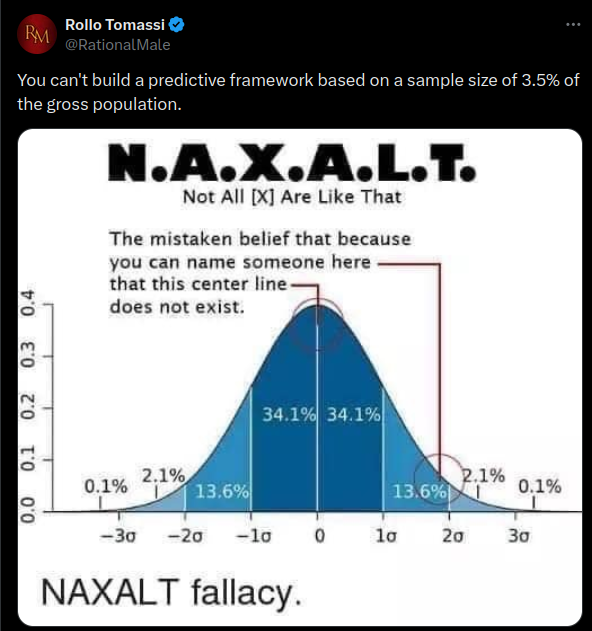
The above post on X by Rollo Tomassi is amazing because it’s wrong in two ways:
First, AWALT is what is known as the ecological fallacy in statistics. You cannot generalize from the mean of a group to individuals within the group. This is because a lot of individuals are not anywhere near the mean, which should be obvious when you look at a normal distribution. A full 32% of individuals are a full standard deviation away from the mean. Even those closer than that can be remarkably different. NAWALT is empirically true; in fact a huge part of evolutionary psychology is understanding precisely how individual women are different from one another.
In fact, it isn’t even the case that knowing average differences or trends lets you make a good predictive model for individual behavior. You can do it, but you need large relationships, which psychology rarely produces. I have written about why AWALT will be wrong more often than not in the past. You can see what happens when you try to generalize to individuals here:
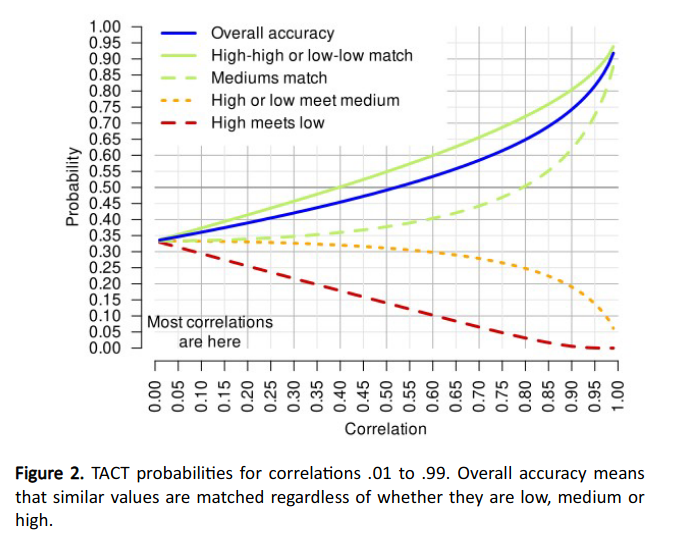
Second, 3.5% of a population is often enough to generalize from. People often struggle to understand how seemingly small samples can accurately reflect a population, but this is a basic and fundamental part of statistics. For example, a random sample of 1000 people can be used to generalize to the entire U.S. population of 3.6M people with a margin of error of only 2% at a CI of 95%. It’s true that you can’t generalize from a nonrepresentative sample drawn from the tails to the mean, but you also can’t generalize from the mean to anywhere else in the distribution!
That’s not all, because Rollo Tomassi is actually fine with generalizing from 3.5% of the population to all women (even when it is a nonrepresentative selection from the tails). All you have to do is look at all of his discourse on hybristophilia, or a paraphilic attraction to criminals. The prevalence of this in the female population is similarly low; it’s hard to even study because it’s so uncommon. It is even lower than urophilia, or the desire to be pissed on, in both men and women. However, Rollo is not a numbers guy; anecdotes are convincing to him, he uses them quite often, and he is fine applying the psychology of the crazy tails of the population to the average person.
(At least, Rollo Tomassi is happy with this as long as it is consistent with his ideology, because one could easily point toward the “MugShawties” community of 500,000 men lusting over female mugshots, or the substantial fanmail female criminals receive from men in jail, or the higher fertility rates of female criminals, to come to the same conclusions that he does: men are hybristophiles, men love criminals!)
Rollo Tomassi has posted a 2018 interview between Martie Haselton and Gad Saad dozens of times. This is a statistical topic, so it fits in here. In this interview, Haselton and Saad discuss controversies in the ovulatory shift research. Among those was a 2014 meta-analysis by Wood et al. where the authors speculated that many results in ovulatory shift research may be false positives produced by p-hacking.
If you aren’t familiar with p-hacking it is essentially this: researchers play with the data in ways that they force a statistically significant result. One tool for detecting p-hacking is the p-curve analysis. If the results across a body of research are not p-hacked then you should see a skew. If they are p-hacked then you will see a lot of p-values clustered around .05 — the cutoff for statistical significance.
The same team of Gildersleeve, Haselton, and Fales conducted a p-curve analysis in 2014 to show that p-hacking was not common in the ovulatory shift literature. All good — evolutionary psychologists are mostly honest and not using questionable research practices.
Rollo Tomassi may have misunderstood this, however. He seems to think that p-hacking is why most of the recent ovulatory shift research doesn’t replicate. In one post he wrote, “30+ years of dual mating has been the target of p-hacking” and in another he wrote “here’s Dr. Haselton explaining how the non-replication bullshit was really the result of p-hacking by feminist haters.” In this video entitled “Why Does Evolutionary Psychology HATE The Red Pill,” starting around 1:45:00, he makes the same claim: p-hacking is when feminists don’t replicate your paper. He has a number of posts like this, but the gist of it is that he thinks the research fails to replicate because female researchers are p-hacking the null hypothesis.
In theory you could p-hack null results, but you could also detect this in a similar way, and no one has ever claimed this is what was happening. Null results are harder to publish and what is much more common is a file drawer effect, or null results never seeing the light of day. This cannot be detected by a p-curve analysis and it also means that most effect sizes in psychology are smaller in reality than they are in published research. (Keep in mind that we already know ovulatory shift effects, if they exist, are small. Now imagine something smaller.)
Additionally, it has not been “feminist haters” that have failed to replicate this research. It has been evolutionary psychologists who would be happy to see it replicate. In some cases, it is the exact same teams of researchers who did the early research who can’t replicate it later. Many of the researchers, perhaps even most at a quick glance, are men. Remember how Gangestad, originator of the dual mating hypothesis of ovulatory shifts, said he isn’t sure it is even real now?
We could also point out that most of what doesn’t replicate comes from social psychology (20% replication rates) and not evolutionary psychology. You can see Schimmack’s False Psychology Glossary for a list, but these are overwhelmingly the darling hypotheses of left-leaning and feminist psychologists. You can also see Schimmack’s 2022 Replicability Rankings of Psychology Journals; evolutionary psychology, personality psychology, and sex research tend to be fields that top the list of the most replicable subdomains in psychology.
Then again, Rollo Tomassi doesn’t seem to understand replication itself, either. Going back to his comments on this interview between Joe Rogan and David Buss he confuses replication with the practice of mis-citing research. Around 10% of citations in psychology papers are wrong; what the author writes and cites isn’t what the cited research found. However, this is not a replicability issue. Mis-citations in research have no bearing on the fact that some experiments, when done a second time, don’t produce significant results.
Ovulatory shifts in mating preferences are among the least controversial and also one of the more obscure topics in these fields. The idea that feminists are faking the results is a spurious claim; it is based on nothing. It’s an obvious cope and it is yet another example of how Rollo Tomassi defaults to conspiratorial thinking. Ovulatory shift effects might just be really hard to replicate because many are not real and the real ones are weak interaction effects — or maybe it’s those damned “feminist haters” out to get him!
How The Red Pill Cherry-Picks
Martie Haselton is, herself, a feminist. Her book Hormonal begins almost as a feminist manifesto would. The title of the introduction is “A New Darwinian Feminism” and she immediately attacks what are essentially common beliefs in the red pill. It has countless feminist conclusions from the ovulatory shift research that I have never seen Rollo Tomassi share even once. “Misinformed sexists still find a way to twist the truth and use biological differences as a hurdle too high for women to clear,” she writes, challenging the idea that “biology is destiny” and that “females have little to no control over their actions because they are governed by their biology.” Contrast this with Rollo Tomassi’s unsupported claims that “women’s only real agency is their sexuality” or “women have no intrinsic agency.”
As I wrote, Rollo Tomassi has come up with very few ideas of his own. It is especially ironic that he has been influenced so heavily by a feminist psychologist.
Of course this only works if you cherry-pick from the literature to spin a story. For example, early research on ovulatory shifts found that, when ovulating, women prefer men who are more masculine (or who have sexually dimorphic features) and more behaviorally dominant. Martie Haselton describes this in Hormonal, but she also describes another effect: women avoid criminals when ovulating.
In a study with over six hundred women (a sample much larger than most ovulatory shift research has used) women were exposed to the mugshots of two men: a man convicted of tax evasion and a man convicted of assault. The man convicted of assault was judged as taller and more muscular by ovulating women, but he was less appealing: “When a woman is clued in to danger of possible sexual assault (and her ability to freely choose her partners), the big guys are not going to be the most appealing. These findings fit in with the idea that women, in general, are cautious about risk and possess a kind of internal alarm system. And at high fertility, that system is fully alarmed.”
Contrast this with Rollo Tomassi’s claim that “hypergamy” is when women pick “alpha criminals,” “chicks love criminals,” and “they all love criminals.”
In fact, in her book Hormonal, Martie Haselton explains how ovulation primes women to avoid men who are a sexual assault risk. In Rollo Tomassi’s commentary on the interview between Joe Rogan and David Buss he claimed that ovulation makes women more attracted to men high in the Dark Triad and referenced the work of Martie Haselton to support this. It’s not anywhere in her book nor in any of her papers; quite the opposite. The “Sexy Cad” Haselton describes is primarily someone who is just physically attractive.
Even within the research lines Rollo Tomassi generally likes, there is a lot he doesn’t share with his audience. The red pill is a collection of “unflattering truths about female nature,” to paraphrase Rollo Tomassi, but only because he cherry-picks those “truths” to show you. Among the most robust findings in evolutionary psychology are that men tend to behave worse than women across a myriad of domains: crime, rape, infidelity, telling lies, and much more. David Buss wrote a whole book about this entitled, “When Men Behave Badly: The Hidden Roots of Sexual Deception, Harassment, and Assault.”
Women could build an ideology around evolutionary psychology blacker than the void by focusing exclusively on this. Indeed, some extreme feminists do just that, exactly as Rollo Tomassi does in the opposite direction. Perhaps the real difference is that “lots of women would be willing to have sex with the hot pool boy” is nowhere near as dark as “lots of men would be willing to rape women in a warzone.”
Motivated Reasoning, Again
The “small sample” excuse is one of the most popular ways laymen simply dismiss research that they don’t like. It can occasionally be a legitimate critique, but one easy way to tell is if someone ever raises the same objection for results that they do like. Rollo Tomassi is no exception here. In this post he critiques a sample of 319 incels (yes this is a paper by the same authors who were the subject of his conspiracy theory). In this post Rollo Tomassi isn’t happy with a sample of 5,000! Maybe he only believes research with even bigger samples?
Well no. In this post he refers again to the old ovulatory shift research, where the sample sizes are about 50 to 80 people on average. Here Rollo Tomassi shared a paper with a sample size of 254 because he liked the results. In this post, Rollo Tomassi wrote, “The science is settled. Chicks dig Jerks” about a paper with a sample size of 128. Here is one with 112 women. Here Rollo Tomassi shared one paper on ovulatory shift effects with only 39 participants. In fact most of the studies he shares or links have samples well below 300; the average sample size in psychology is about 80 people.
This is not a pissing match of “who has larger samples,” but to illustrate the degree of inconsistency and motivated reasoning that we are looking at. Seemingly small samples are fine, except when the results don’t go the way that you want, then they are bad.
Well maybe the real issue isn’t small samples, but that the samples are nonrepresentative? This is one issue he has raised with the aforementioned incel research, too, as well as my own. I have run over 20,000 participants across a couple of dozen surveys over the last two years, but Rollo Tomassi does not like this because they are sourced from the Internet.
Yet this can’t be the case, either, because the examples of papers I have given that he has promoted have also been nonrepresentative and Internet samples! In fact about 95% of samples in psychology are nonrepresentative and about 50% are sourced online now. This has limitations, but it isn’t a crucial problem; if it were then psychologists wouldn’t use these samples at all. Further, Rollo Tomassi doesn’t seem to find it to be a problem either (as long as he thinks that the results are congruent with his dogma).
Basically, the methodology is bad when it produces results that Rollo Tomassi doesn’t like and the methodology is good when it produces results that he does like, even when the methodology is the same!
I don’t think Rollo Tomassi has any real opinions about research methodology or statistics. He is not an academic nor a researcher. He has no formal training in conducting research nor is there any indication that he has ever taught himself any of these skills. That is completely normal; if that was what he wanted to do then he would be doing that instead.
But Rollo Tomassi does occasionally like to throw up a chart. Here is a famous one he made:
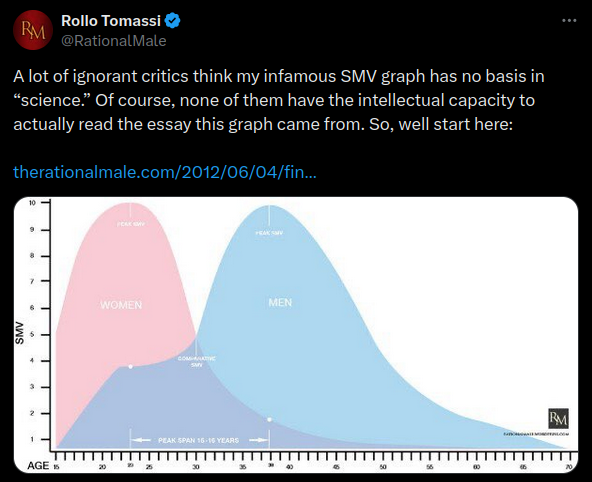
The problem is that it is fake. It isn’t based on any underlying data at all. I am sure that this indeed represents what he feels to be true, but this was constructed in Photoshop or some other editing program. I have had multiple people ask me where they can find the dataset that was used to make this and I have had to tell them that there is no dataset.
To be fair, the trend that men peak in mate value later than women is true. Nonetheless, the distributions and numbers on the chart are made up. Actual data on “peak sexual value” shows a different and more complex picture. In my own surveys on age gaps and in the large OKCupid dataset, women show very narrow age preferences for men who are close to their own age. In revealed behavior, it is quite rare for women to select men who are much older than them. Men in their late 30s tend to get rated as less physically attractive on average than men in their mid to late 20s, too. Jake Kozloski, owner of a large dating app and matchmaking service, also found that past age 30 men begin to get rejected much more than younger women. If the peak sexual value of men and women were age 36 and age 23 respectively, we might expect a lot of pairings between these groups given assortative or hypergamous mate selection. Yet we don’t. The average age gap between couples is only 2-4 years.
The chart is yet one more example of how Rollo Tomassi doesn’t mind making things up and presenting them as if they were true. Further, the disconnect between the chart and the real-world data of both stated and revealed mating preferences shows how this can contribute to forming an incorrect mental map of the landscape.
Evolution Is Inconvenient For The Red Pill
Rollo Tomassi claims to be inspired by evolutionary psychology, so you would think he also embraces all of the well-understood mechanisms of evolution itself. It turns out that isn’t true. Would you be shocked to learn that he thinks assortative mating is not real?
Assortative mating is the observation that mating is non-random and that organisms select mates who are similar to themselves. It is not a hypothesis or a theory; it is an empirical observation across the animal kingdom. It is one of the mechanisms through which traits are selected for and propagated in future generations. There are no evolutionary biologists nor psychologists who have ever proposed that assortative mating is not real. It would be like saying sexual selection is not real.
But Rollo Tomassi does assert that assortative mating is not real. In one post, he presented the photos of two unattractive people and wrote, “If the ‘assortive mating’ hypothesis were true, these two would be married with 2 kids by now.” In another post he wrote, “If assortive mating was ever a thing women wouldn’t be agonizing over settling on a man who isn’t the best they could do.” In yet another he wrote, “One more coffin nail for assortive mating Disney wishes.” And yet again, “So much for the Assortive Mating theory.”
Yes, he spelled assortative wrong in all of these.

Even more glaring, the third from the last was about a paper on assortative mating. It found quite high correlations between the traits of individuals and their romantic partners. Age correlated at .87, physical attractiveness at .41, and income at .33. There was no correlation between partners trait extraversion, so because of that Rollo Tomassi presented this paper as assortative mating is not real.
This is a common pattern with how Rollo Tomassi uses and reports research. In fact, Rollo Tomassi has misrepresented or misreported dozens of papers on his social media account. This often looks like a gish-gallop of link spam accompanied by one-liners like “more proof the mate switching hypothesis is horseshit.”
It’s remarkable that this has gone on for as long as it has. You might think people would have caught on, but past research has found only around 5% of the people who read academic X/Twitter posts click the link. Further, because academic papers are often paywalled it becomes even more difficult for the average reader to assess how they are presented beyond the abstract. Rollo Tomassi loves to say “there are tons of studies,” yet rarely presents any, then deviates into musings about how something like 50 Shades of Grey proves it and you don’t really need any studies at all (see again the Rogan and Buss interview commentary where he does exactly this).
Basically he is expecting you not to read the papers — and it seems to work. A lot of the time he isn’t reading them either.
Below is a large selection of posts Rollo Tomassi has made. It’s a mixture of links to papers, pop psychology musings about celebrities, and assorted claims. It’s the Rollo Gets A Lot Really Wrong section.
Rollo Tomassi Gets A Lot Wrong
Rollo: “I thought mate switching said women only cheat up the socioeconomic scale?”
Nope. The mate switching hypothesis makes no necessarily predictions about selecting “up” the socioeconomic ladder. The mate switching hypothesis is simply the hypothesis that one adaptive function of infidelity is to leave one mate for a new one.
Rollo: “More proof that the mate switching hypothesis is horseshit.”
This is a paper I posted that found women who have friends-with-benefits relationships have higher self-esteem. It makes no mention of the mate switching hypothesis and doesn’t test the mate switching hypothesis at all.
Rollo: “Kill shot for the mate switching hypothesis.”
This is a paper that found sexual frequency and quality did not predict infidelity. It did not contain anything at all about the mate switching hypothesis.
Rollo: “And down goes the mate switching hypothesis.”
This is a link to a generic bell curve plot and the claim that the top men are sleeping with most women.
Rollo: “Another example of women mate switching up to a higher status 14 y.o. middle schooler.”
This is a link to a NY Post article about a teacher who had sex with her minor student.
The mate switching hypothesis says nothing in regards to how ovulation factors into women’s sexual strategies. The mate switching hypothesis explains one adaptive function of infidelity: to leave a current mate for a new mate.
Rollo: “This proves every point l’ve ever made, girls can leave you for jobless manipulative losers if they just play their cards right.” I take it Destiny doesn’t place much faith in Mate Switching Hypothesis then?”
Twitter user response: “How does the mate switching hypothesis fit into this? Destiny is higher status than the other guy so this shouldn’t have happened according to that theory, no?”
Rollo: “My point exactly. Thanks.”
The mate switching hypothesis does not propose that women should never leave higher status men for lower status men. Women can leave for any reason, for example, subjective feelings of happiness. The wife of the influencer Destiny left him to be in a relationship with another man. It is quite literally mate switching: leaving a current long-term partner for a new long-term partner. Rollo Tomassi made this same mistake throughout his commentary on the interview between Joe Rogan and David Buss linked earlier in this article.
Rollo: “Every day there’s a new example of Dual Mating strategy destroying Mate Switching hypothesis.”
This was a celebrity gossip tabloid about the divorce of Brazilian football player Ricardo Kaka. There is no indication that there was infidelity nor even a new romantic partner for Kaka’s ex-wife. This is not anecdotal support for or against the dual mating hypothesis, nor the mate switching hypothesis. This is a tabloid story about celebrities.
Rollo: “Ovulatory Shift replicates quite well when you observe it in the wild:”
This is a link to a PsyPost article on a study that found no effect of ovulation. It is exactly the opposite of how Rollo Tomassi presented it. It is explained right in the abstract and the PsyPost article: “Analyses failed to reveal menstrual cycle effects.”
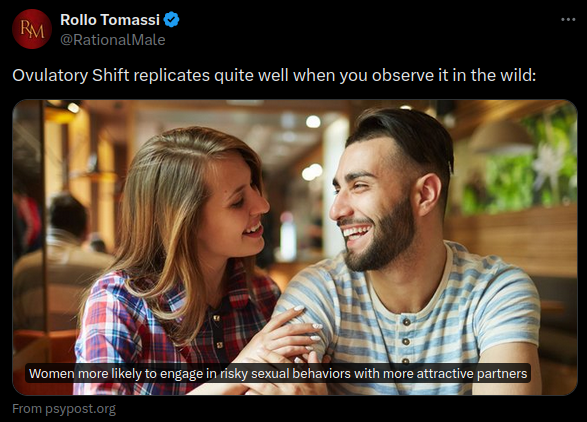
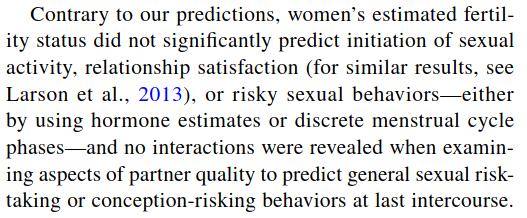
Rollo: “Dual mating strategy and ovulatory shift replicates once again.”
This is not a replication study at all. This is a story from an anonymous Reddit post. Remember, Rollo Tomassi calls a lot of weird things “replications.”
Rollo: “Covid 19 vaccine sterilizes men, women most affected.”
This is a local news article where one urologist said we need to study the effects of the COVID-19 vaccine on male fertility. There was no claim made that it sterilized men.
The dual mating hypothesis proposes that infidelity is an evolved sexual strategy to secure “good genes” from an extra-pair sire and investment from a long-term mate. Structural changes in the brain during the menstrual cycle are something, but they are not evidence for the dual mating hypothesis. This is again the Rorschach test: Rollo Tomassi presents anything related to ovulation at all as the “dual mating hypothesis.”
The dual mating hypothesis is not synonymous with hypergamy. Hypergamy merely refers to a selection “up” relative to oneself, but the desire for an attractive mate alone is also not “hypergamy.”
The dual mating hypothesis is about infidelity: to secure the “good genes” of an extra-pair sire while simultaneously securing parental investment from another partner. It is a hypothesis proposed to explain extra-pair mating in a predominately pair-bonding species. Here Rollo Tomassi may be confusing the dual mating hypothesis with Sexual Strategies Theory (we have different mating preferences for short and long term mates).
There is some evidence that female eggs “choose” which sperm to accept. This is determined in part by genetic compatibility. The results tell you nothing about assortative partner selection, but they do show that assortative genetic selection occurs even at conception. Women are less likely to conceive following sex with men who are too genetically dissimilar from themselves.
Cuckoldry is not “women’s innate mating strategy.” No evolutionary psychologist has ever claimed such a thing. Cuckoldry is one potential mating strategy that is not universally expressed in women and, in fact, is expressed in only a small minority of women.
“Feminine-primary polyandry” is not the predominant mating strategy. Monogamy remains the predominant mating strategy; few people have multiple concurrent mates.
Research on women’s selection of sperm donors shows homogamous or assortative selection, too!
Only about 3-5% of animals are monogamous, but 30% of primate species are. Homo sapiens are a long-term pair bonding species and one of the more monogamous mammals.
This is entirely made up. Research on sex differences in cognitive dissonance show either null effects (men and women both experience cognitive dissonance) or women experience more cognitive dissonance. Cognitive dissonance theory itself has also come under recent empirical and theoretical challenges given nonreplications of the original research by Festinger.
If female selections are on average hypergamous then men’s selections are on average hypogamous. For example, if women select “up” in income or attractiveness on average, more men will have higher incomes or be of higher attractiveness than their partners on average: their selections will be hypogamous. Importantly, neither men nor women show hypogamous preferences. Men and women both prefer more attractive or desirable mates. In preferences, both men and women are “hypergamous.” In mate selection, men are less selective, and are often “hypogamous.”
“Female solipsism” is entirely an invention of the red pill. No evolutionary psychologist has ever claimed this; it is baseless to assert that evolution selected for this. The closest psychological construct or cognitive ability to solipsism is perhaps theory of mind — and women score higher in this than men on average.
This is a link to a study that did find an effect of fertility, but it was not as “AFBB” predicts. Fertile women were more demanding both for long and short-term mates — and traits desirable in long-term relationships were demanded more even in potential short-term partners. “Contrary to predictions made by the ovulatory shift hypothesis,” the authors concluded. Also no effect of ovulation on a desire for dominance (as Rollo Tomassi claimed in his commentary on the Rogan interview).

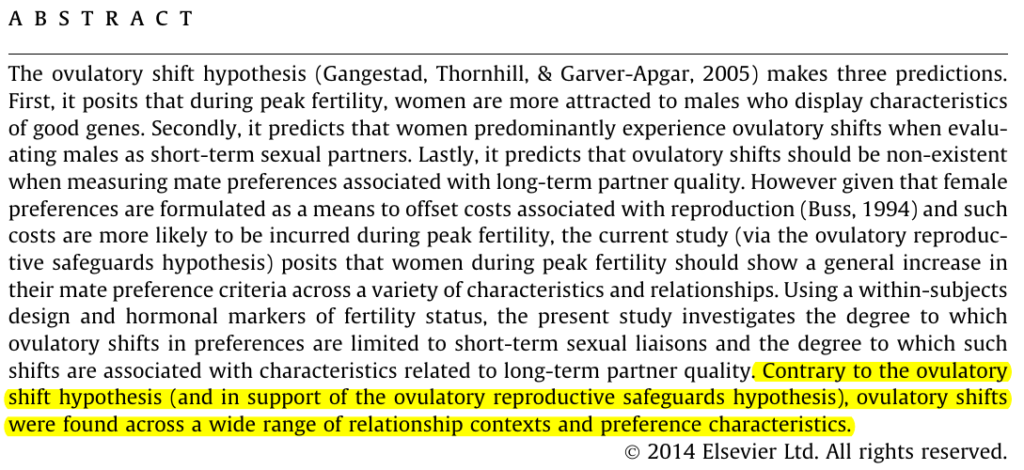
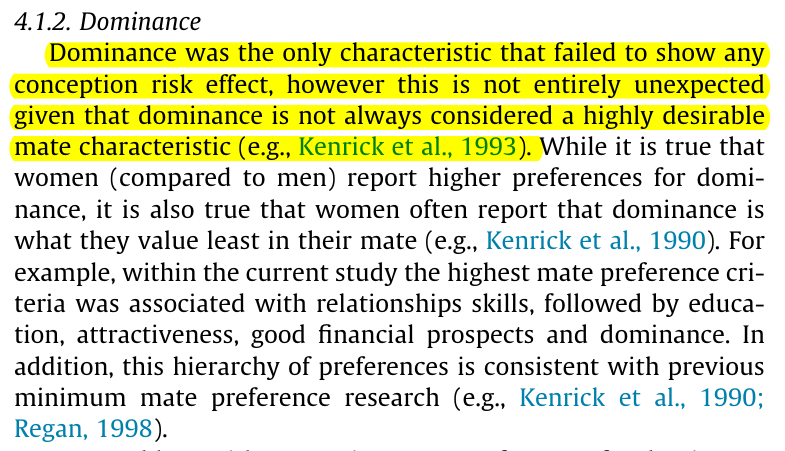
Rollo: “More proof that short haired women are damaged.”
This is a link to a study that tracked the facial attention of infants. Infants did not respond differently to hairstyle nor length. There was no effect of having short hair at all.

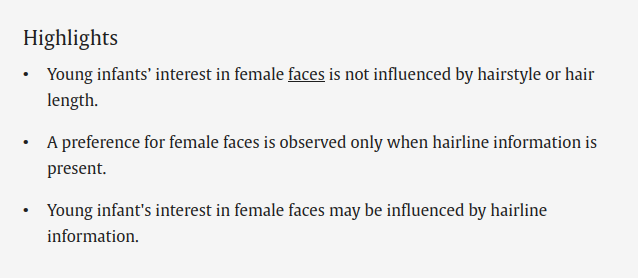
Trait psychopathy was not associated with more children for women in this paper, only for men. However, criminal behavior and other measures of antisocial behavior were associated with women having more children. Men love criminals?
Discussion
Evolutionary psychologist Daniel-Conroy Beam recently wrote an article entitled, “How Incels Warped My Research” describing how one manosphere community (“involuntary celibates”) distorted findings from evolutionary psychology to its own ends. The evolutionary psychologist Andrew Thomas also wrote an article entitled “Combating the Misuse of Evolutionary Psychology Research“ describing similar trends. Macken Murphy, an evolutionary psychologist with a large social media platform, has been great about combating manosphere misrepresentations of the field and has tangled with popular influencers such as “Hoe_Math.” Facing the left, too, evolutionary psychologist William Costello and myself have challenged misrepresentations of the field from progressives.
The younger generation of evolutionary psychologists are more active and social media-saavy than earlier generations, putting them in contact with early popularizers of evolutionary psychology from influencers. Misrepresentations of evolutionary psychology abound — the field and its research provide a convenient tool for some people to point at and justify their ideology with a sort of intellectual slight-of-hand. Red pill influencers like Rollo Tomassi can point to a paper and claim, “see, it justifies my belief” the same way left-wing influencers like Münecat point to the very same papers and say “see, it justifies the belief of my enemies.”
The truth is elsewhere; both misrepresent the field to their own biases and misrepresent the literature within it. Their presentation of evolutionary psychology is a caricature of cherry-picked papers used to tell a story.
When I read Daniel’s article “How Incels Warped My Research,” I went back and checked the Incel Wiki entry for the Dark Triad. I had recently written a literature review on the Dark Triad, so I wanted to see how it matched up with mine. I clicked every link and compared the way the paper was presented against the description or reference to it in the Wiki. Actually, it was quite accurate. The worst I can say was that the Incel Wiki omitted some research. It really wasn’t that bad, at least for that page.
I can’t say the same for the work of Rollo Tomassi. His work is a mishmash of celebrity gossip, strong feelings presented as facts, and misrepresentations of the literature to the extent that he often presents the exact opposite of what the paper found as if it were true. His book and blog contain few to no references, making it hard for a lay reader to distinguish between what is based on evolutionary research (e.g. the dual mating hypothesis) and what is a creation of his own with no empirical support (e.g. “women evolved to be solipsistic”). If you watch his shows you will get a heavy dose of his own musings, as well as the musings of the many sex workers and pornstars that he has on, but almost nothing substantial from evolutionary psychology. If you follow his X/Twitter account you will find 90% of it is beef with other influencers (he has made hundreds of posts about Jordan and Mikhaila Peterson).
As far as Rollo Tomassi’s errors and misrepresentations, this article merely scratches the surface. It ended up being much longer than I expected it to be because there was so much to choose from. The main takeaway perhaps is that if you want to learn about evolutionary psychology, Rollo Tomassi is a terrible source. You would do much better to simply read the work of evolutionary psychologists.
5 comments
Alexander thanks so much for your absolutely exemplary work in this area of interpersonal relationships, romantic relationships, and personal development. As with politics, there are some people (such as the one mentioned in this article) who profit or gain in other ways from fomenting polarisation, either/or dichotomies, and misinformation that is not supported by high-quality evidence. This is stoking division, anger, misogyny, and, in the worst cases, violence. Your work is bringing order to chaos, educating men like myself, and helping to bring understanding, calm, personal growth, and great relationships. Thanks again for your amazing work Alexander!
What’s funny about the conspiracy theory on Costello is that feminists actually HATE his research. Costello’s research shows that we (incels) are politically and ethnically diverse (so not a part of the alt-right), are more likely to be autistic (obv makes dating hard), and most importantly that we suffer. This is the exact OPPOSITE of the feminist narrative, which holds that incels are just a subset of the alt-right.
” “Female solipsism” is entirely an invention of the red pill. No evolutionary psychologist has ever claimed this; it is baseless to assert that evolution selected for this. The closest psychological construct or cognitive ability to solipsism is perhaps theory of mind — and women score higher in this than men on average.”
… and because evolutionary psychology has not published on it, then it should not real right ?”
Solipsism is very well defined, in RT and as far and as a predictive model it has helped me navigate life better than a compass on dense forest.
I don’t know man, I don’t disagree that there is echo chamber in red pill but it seems to be that the biggest echo chamber lies between the ears of someone that has picked a narrative and works his models backwards to fit that: some red herrings here, some strawman over there, a bit of data picking and suddenly the great feeling that ‘he’ is right and all the red pill guys are wrong – which is all what you are about.
And no I don’t always disagree with you, as I don’t always agree with Red Pillers – but I think you should start by curbing your arrogance, cause not everyone on the internet is statistically illiterate ok ? 😉
Theory of mind (Wikipedia):
“In psychology, theory of mind refers to the capacity to understand other people by ascribing mental states to them. A theory of mind includes the understanding that others’ beliefs, desires, intentions, emotions, and thoughts may be different from one’s own.[1]
(…)
The “theory of mind” is described as a theory, because the behavior of the other person, such as their statements and expressions, is the only thing being directly observed; no one has direct access to the mind of another, and the existence and nature of the mind must be inferred.[11] It is typically assumed others have minds analogous to one’s own; this assumption is based on three reciprocal social interactions, as observed in joint attention,[2] the functional use of language,[12] and the understanding of others’ emotions and actions.[13] Theory of mind allows one to attribute thoughts, desires, and intentions to others, to predict or explain their actions, and to posit their intentions. It enables one to understand that mental states can be the cause of—and can be used to explain and predict—the behavior of others.[11] Being able to attribute mental states to others and understanding them as causes of behavior implies, in part, one must be able to conceive of the mind as a “generator of representations”.[14] If a person does not have a mature theory of mind, it may be a sign of cognitive or developmental impairment.[15]”
Solipsism according to Rollo Tomassi (Solipsism II):
“One of the most eye opening of the solipsistic world of females was when a plate of mine was giving me directions on where to pick her up. It went something like this:
Her: “When you come to that traffic light, turn over to me.”
Me: “What do you mean?”
Her: “Just turn here towards me.”
Me: “How the hell am I supposed to know which way is that? Left or right?”
Her: “I don’t know. Just turn my way”
She eventually gave directions, but it amazed me how hard it is for a woman to put herself in someone else’s shoes, even if she wants to.
(…)
Women’s mental point of origin (solipsism) presumes the entire world outside of her agrees with her imperative and mutually shares the importance and priorities of it.
(…)
It’s always the “not-in-my-case” story about how their personal anecdotal, exceptional experience categorically proves a universal opposite. By order of degrees, women have a natural tendency for solipsism – any dynamic is interpreted in terms of how it applies to themselves first, and then the greater whole of humanity.
Men tend to draw upon the larger, rational, more empirical meta-observations whether they agree or not, but a woman will almost universally rely upon her isolated personal experience and cling to it as gospel. If it’s true for her, it’s true for everyone, and experience and data that contradict her self-estimations? Those have no bearing because ‘she’s’ not like that.”
They seem to be opposite terms, I don’t know why Alex wrote that theory of mind is close to solipsism.
I find hilarious that an example of “women’s solipsism” is just a woman with poor spatial skills; redpill folks die hard on “men and women are different” but they then forget one of the major differences between men’s and women’s cognitive abilites. The last paragraph is the same what redpill dudes do; when science doesn’t benefit their narrative, then anecdotes and TikToks are meaningful insights on women’s nature. Rollo himself, to define women’s innate solipsism, use anecdotes, not science.
Alex didn’t say that female solipsism is disproved. He said there was no proof to back up Rollo’s claims. Important distinction. Maybe in the future there will be an actual study showing it to be real, but until then it’s on Rollo to provide the proof – which I doubt he can.
“Solipsism is very well defined, in RT and as far and as a predictive model it has helped me navigate life better than a compass on dense forest.”
I obviously don’t know anything about you and that way of thinking may well have helped you, but what you might call a defining trait of the human brain is that’s it’s very good at filtering out experiences that don’t conform to our expectations and biases. This is something that’s exploited in cold-reading (horoscopes, palm reading, stage mentalism etc.) where even if, say, only one out of ten predictions come true, the mark/client/spectator will consider it a success because they will conveniently “forget” or otherwise explain away the nine predictions that failed. Same thing for you, where you probably only remember the times where the situation fit your expectations for female solipsism, but maybe never even noticed when it didn’t – even if that was the majority of times. If you want to learn more about cold-reading, I can highly recommend “The Full Facts Book of Cold Reading” by Ian Rowland.
“but it seems to be that the biggest echo chamber lies between the ears of someone that has picked a narrative and works his models backwards to fit that”
That would be Rollo you’re describing here, not Alex. This whole article is about proving that.
“cause not everyone on the internet is statistically illiterate ok ?”
If you’re as statistically literate as you claim, then you would know that n = 1 is not a statistic, but an anecdote. That is, your personal experience (correctly remembered or not) says nothing on its own about how the world at large works.